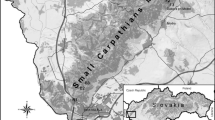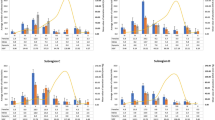Abstract
Ixodes ricinus is the most common tick species in Europe and vector of many diseases of humans. The risk of contracting such a disease is influenced by many factors, but one of the crucial points is questing activity of unfed ticks. In order to supplement the few literature data on patterns of diel activity of this tick species and to examine the correlations between data on diel activity of ticks and their small mammal hosts and some meteorological variables, a survey was performed. Diel activity of questing I. ricinus and small rodents was studied in a known natural tick-borne encephalitis virus focus over 7 months at one sampling day monthly. 1,063 I. ricinus ticks and 25 rodents were sampled. Air temperature and humidity data were also recorded in the 24 study plots at time of sampling. From April to October questing activity of nymphs increased in the 3-h-period after sunrise, comparing to activity of the 3 h before sunrise. Proportion of nymphs sampled 3 h after sunset compared to total sampled nymphs 3 h before and 3 h after sunset showed correlation to activity of rodents. In the period of April–July both nymphs and larvae showed stronger activity from sunrise to sunset, this turned to dominant nighttime activity in August–September, whereas activity changed to equal in day and night in October. Our results indicate that natural light and rodent population have positive effect on questing activity of I. ricinus.

Similar content being viewed by others
References
Allan BF, Keesing F, Ostfeld RS (2003) Effect of forest fragmentation on Lyme disease risk. Conserv Biol 17:267–272
Balogh Z, Ferenczi E, Szeles K, Stefanoff P, Gut W, Szomor KN, Takacs M, Berencsi G (2010) Tick-borne encephalitis outbreak in Hungary due to consumption of raw goat milk. J Virol Methods 163(2):481–485
Duffy DC, Daturi A (1987) Diel rhythms of tick parasitism on incubating African penguins. Med Vet Entomol 1:103–106
Estrada-Peña A (2003) The relationships between habitat topology, critical scales of connectivity and ticks abundance Ixodes ricinus in a heterogeneous landscape in northern Spain. Ecography 26:661–673
Gray JS (1991) The development and seasonal activity of the tick Ixodes ricinus: a vector of Lyme borreliosis. Rev Med Vet Entomol 79:323–333
Knap N, Durmiši E, Saksida A, Korva M, Petrovec M, Avšič-Županc T (2009) Influence of climatic factors on dynamics of questing Ixodes ricinus ticks in Slovenia. Vet Parasitol 164:275–281
Lane RS, Kleinjan JE, Schoeler GB (1995) Diel activity of nymphal Dermacentor occidentalis and Ixodes pacificus (Acari: Ixodidae) in relation to meteorological factors and host activity periods. J Med Entomol 32:290–299
Mejlon HA (1997) Diel activity of Ixodes ricinus Acari: Ixodidea at two locations in Stockholm, Sweden. Exp Appl Acarol 21:247–255
Perret JL, Guerin PM, Diehl PA, Vlimant M, Gern L (2003) Darkness induces mobility, and saturation deficit limits questing duration, in the tick Ixodes ricinus. J Exp Biol 206:1809–1815
R Development Core Team (2011) R: A language and environment for statistical computing. R Foundation for Statistical Computing. Vienna, Austria. http://www.R-project.org.
Tack W, Madder M, Baeten L, Vanhellemont M, Gruwez R, Verheyen K (2012) Local habitat and landscape affect Ixodes ricinus tick abundances in forests on poor, sandy soils. Forest Ecol Manag 265:30–36
Acknowledgments
We thank Szabolcs Ádámszki, Gábor Földvári and Gyula Takács for their occassional help in sampling. The study was funded by the Hungarian National Research Found (OTKA) Grant No. K 81258.
Author information
Authors and Affiliations
Corresponding author
Rights and permissions
About this article
Cite this article
Zöldi, V., Reicziegel, J. & Egyed, L. Monitoring the diel activity of Ixodes ricinus ticks in Hungary over three seasons. Exp Appl Acarol 61, 509–517 (2013). https://doi.org/10.1007/s10493-013-9708-4
Received:
Accepted:
Published:
Issue Date:
DOI: https://doi.org/10.1007/s10493-013-9708-4




